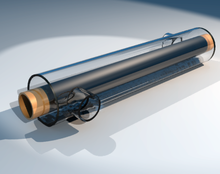Our website is made possible by displaying online advertisements to our visitors.
Please consider supporting us by disabling your ad blocker.
Heat exchanger


A heat exchanger is a system used to transfer heat between a source and a working fluid. Heat exchangers are used in both cooling and heating processes.[1] The fluids may be separated by a solid wall to prevent mixing or they may be in direct contact.[2] They are widely used in space heating, refrigeration, air conditioning, power stations, chemical plants, petrochemical plants, petroleum refineries, natural-gas processing, and sewage treatment. The classic example of a heat exchanger is found in an internal combustion engine in which a circulating fluid known as engine coolant flows through radiator coils and air flows past the coils, which cools the coolant and heats the incoming air. Another example is the heat sink, which is a passive heat exchanger that transfers the heat generated by an electronic or a mechanical device to a fluid medium, often air or a liquid coolant.[3]
- ^ Al-Sammarraie, Ahmed T.; Vafai, Kambiz (2017). "Heat transfer augmentation through convergence angles in a pipe". Numerical Heat Transfer, Part A: Applications. 72 (3): 197–214. Bibcode:2017NHTA...72..197A. doi:10.1080/10407782.2017.1372670. S2CID 125509773.
- ^ Sadik Kakaç; Hongtan Liu (2002). Heat Exchangers: Selection, Rating and Thermal Design (2nd ed.). CRC Press. ISBN 978-0-8493-0902-1.
- ^ Farzaneh, Mahsa; Forouzandeh, Azadeh; Al-Sammarraie, Ahmed T.; Salimpour, Mohammad Reza (2019). "Constructal Design of Circular Multilayer Microchannel Heat Sinks". Journal of Thermal Science and Engineering Applications. 11. doi:10.1115/1.4041196. S2CID 126162513.
Previous Page Next Page


